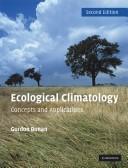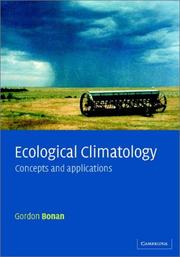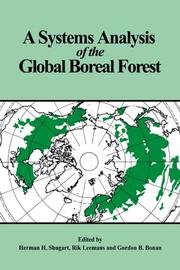| Listing 1 - 10 of 11 | << page >> |
Sort by
|

ISBN: 9780521693196 9780521872218 0521693195 0521872219 Year: 2008 Publisher: Cambridge : Cambridge University Press,
Abstract | Keywords | Export | Availability | Bookmark
 Loading...
Loading...Choose an application
- Reference Manager
- EndNote
- RefWorks (Direct export to RefWorks)
Meteorology. Climatology --- General ecology and biosociology --- Vegetation and climate --- Plant ecophysiology --- Climatic changes --- Climatologie --- Climatology --- Écosystème --- ecosystems --- Changement climatique --- Climatic change --- Utilisation des terres --- land use --- Impact sur l'environnement --- Environmental impact --- Biogéographie --- Biogeography --- Facteur climatique --- climatic factors --- Climatic changes. --- Plant ecophysiology. --- Vegetation and climate. --- Basic Sciences. Meteorology --- Climatology.

ISBN: 0521804760 0521800323 Year: 2002 Publisher: Cambridge Cambridge University press
Abstract | Keywords | Export | Availability | Bookmark
 Loading...
Loading...Choose an application
- Reference Manager
- EndNote
- RefWorks (Direct export to RefWorks)
Ecological climatology is an interdisciplinary framework to understand the functioning of terrestrial ecosystems in the climate system. It examines the physical, chemical, and biological processes by which landscapes affect and are affected by climate. The central theme is that terrestrial ecosystems, through their cycling of energy, water, chemical elements, and trace gases, are important determinants of climate. The coupling between climate and vegetation is seen at spatial scales from stomata to vegetation geography and at time scales of near instantaneous to millennia. In particular, natural vegetation dynamics and human land uses and land management are important mechanisms of climate change. The boreal forest-tundra ecotone and the North African Sahel are examples of climate-ecosystem dynamics at the biogeographical spatial and temporal scale. Deforestation, desertification of drylands, cultivation of grasslands, reforestation following farm abandonment, and urbanization are case studies of how human uses of land alter climate.
551.58 --- Climatology --- Climatic changes. --- Plant ecophysiology. --- Vegetation and climate. --- Geografie --- Fysische geografie --- Klimaat --- (Klimatologie, Meteorologie, Klimaatsveranderingen) --- (Klimatologie, Meteorologie, Klimaatsveranderingen). --- 551.58 Climatology --- Climatic changes --- Plant ecophysiology --- Vegetation and climate --- Plant bioclimatology --- Plant biometeorology --- Plants --- Plants and climate --- Bioclimatology --- Environmental plant physiology --- Physiological plant ecology --- Plant physiological ecology --- Ecophysiology --- Plant ecology --- Plant physiology --- Changes, Climatic --- Climate change --- Climate changes --- Climate variations --- Climatic change --- Climatic fluctuations --- Climatic variations --- Global climate changes --- Global climatic changes --- Climate change mitigation --- Teleconnections (Climatology) --- Climatic factors --- Effect of climate on --- Effect of climatic changes on --- Environmental aspects --- Changes in climate --- Climate change science --- Global environmental change
Book
ISBN: 9781107619074 9781107339217 9781107043787 Year: 2019 Publisher: Cambridge Cambridge University Press
Abstract | Keywords | Export | Availability | Bookmark
 Loading...
Loading...Choose an application
- Reference Manager
- EndNote
- RefWorks (Direct export to RefWorks)
Climate models have evolved into Earth system models with representation of the physics, chemistry, and biology of terrestrial ecosystems. This companion book to Gordon Bonan's Ecological Climatology: Concepts and Applications, Third Edition, builds on the concepts introduced there, and provides the mathematical foundation upon which to develop and understand ecosystem models and their relevance for these Earth system models. The book bridges the disciplinary gap among land surface models developed by atmospheric scientists; biogeochemical models, dynamic global vegetation models, and ecosystem demography models developed by ecologists; and ecohydrology models developed by hydrologists. Review questions, supplemental code, and modeling projects are provided, to aid with understanding how the equations are used. The book is an invaluable guide to climate change and terrestrial ecosystem modeling for graduate students and researchers in climate change, climatology, ecology, hydrology, biogeochemistry, meteorology, environmental science, mathematical modeling, and environmental biophysics.
Biotic communities --- Ecology --- Climatic changes. --- Global environmental change. --- Mathematical models.
Book
ISBN: 9781107043770 9781107619050 9781107339200 Year: 2016 Publisher: Cambridge Cambridge University Press
Abstract | Keywords | Export | Availability | Bookmark
 Loading...
Loading...Choose an application
- Reference Manager
- EndNote
- RefWorks (Direct export to RefWorks)
Book
ISBN: 9781108467841 9781108487528 1108487521 1108467849 9781108601559 Year: 2023 Publisher: Cambridge, United Kingdom ;New York, NY Cambridge University Press
Abstract | Keywords | Export | Availability | Bookmark
 Loading...
Loading...Choose an application
- Reference Manager
- EndNote
- RefWorks (Direct export to RefWorks)
"The tenth of November 1888 was a fine autumn day before the dreary span of winter in Washington, DC. The afternoon was warm, one of several days with pleasant temperatures, and there was only a trace amount of rain.1 The agreeable weather likely lifted the spirits of Washingtonians, and as night fell and the sky darkened and the temperature dropped, there was an air of excitement and anticipation among leading intellectuals in the nation's capital. Nearly three hundred years of European settlement had greatly altered the landscape of the United States.2 The Virginia and New England countryside found by the first English colonists contained extensive old-growth forest. Thereafter, the landscape was cleared of forests, felled for their wood products and replaced by homesteads, towns, and farmland. The vast virgin forests of New England - towering white pines, giants of the forest, famed for the masts they had provided the navy; mixtures of beech, maple, and birch along with hemlock and spruce in northern states; oaks and hickories in southern New England - had long since been felled.3 Similar widespread clearing had altered the forests of Virginia and other states along the eastern seaboard, and the same pattern of forest clearing was repeated in the Midwest and Great Lakes regions with the westward expansion of the population.4 A popular belief at the time was that deforestation was decreasing rainfall"--
Forest meteorology --- Forests and forestry --- Deforestation --- Forest meteorology. --- Météorologie forestière. --- Forêts --- Déboisement --- Climatic factors. --- Environmental aspects. --- Effets du climat. --- Aspect environnemental. --- Nature protection --- Meteorology. Climatology --- General ecology and biosociology --- Forestry
Book
ISBN: 1280698020 9786613674982 0809386860 1441645683 9781441645685 9780809386864 9781280698026 9780809329328 0809329328 6613674982 Year: 2009 Publisher: Carbondale Southern Illinois University
Abstract | Keywords | Export | Availability | Bookmark
 Loading...
Loading...Choose an application
- Reference Manager
- EndNote
- RefWorks (Direct export to RefWorks)
The Edge of Mosby's Sword is the first scholarly volume to delve into the story of one of John Singleton Mosby's most trusted and respected officers, Colonel William Henry Chapman. Presenting both military and personal perspectives of Chapman's life, Gordon B. Bonan offers an in-depth understanding of a man transformed by the shattering of his nation. This painstakingly researched account exposes a soldier and patriot whose convictions compelled him to battle fiercely for Southern independence; whose quest for greatness soured when faced with the brutal realities of warfare; and
Soldiers --- Guerrillas --- Chapman, William Henry, --- Mosby, John Singleton, --- United States. --- Officials and employees --- United States --- History
Book
ISBN: 1108564054 1108585612 1108601553 Year: 2023 Publisher: Cambridge, United Kingdom ; New York, NY : Cambridge University Press,
Abstract | Keywords | Export | Availability | Bookmark
 Loading...
Loading...Choose an application
- Reference Manager
- EndNote
- RefWorks (Direct export to RefWorks)
For centuries, people have understood that forests, and our utilisation of them, influence the climate. With modern environmental concerns, there is now scientific, governmental, and popular interest in planting trees for climate protection. This book examines the historical origins of the idea that forests influence climate, the bitter controversy that ended the science, and its modern rebirth. Spanning the 1500s to the present, it provides a broad perspective across the physical and biological sciences, as well as the humanities, to explain the many ways forests influence climate. It describes their use in climate-smart forestry and as a natural climate solution, and demonstrates that in the forest-climate question, human and sylvan fates are linked. Accessibly written with minimal mathematics, it is ideal for students in environmental and related sciences, as well as anyone with an interest in understanding the environmental workings of forests and their interactions with climate.
Forest meteorology. --- Forests and forestry --- Deforestation --- Climatic factors. --- Environmental aspects.
Book
ISBN: 1108611397 1108662234 1107339219 Year: 2019 Publisher: Cambridge : Cambridge University Press,
Abstract | Keywords | Export | Availability | Bookmark
 Loading...
Loading...Choose an application
- Reference Manager
- EndNote
- RefWorks (Direct export to RefWorks)
Climate models have evolved into Earth system models with representation of the physics, chemistry, and biology of terrestrial ecosystems. This companion book to Gordon Bonan's Ecological Climatology: Concepts and Applications, Third Edition, builds on the concepts introduced there, and provides the mathematical foundation upon which to develop and understand ecosystem models and their relevance for these Earth system models. The book bridges the disciplinary gap among land surface models developed by atmospheric scientists; biogeochemical models, dynamic global vegetation models, and ecosystem demography models developed by ecologists; and ecohydrology models developed by hydrologists. Review questions, supplemental code, and modeling projects are provided, to aid with understanding how the equations are used. The book is an invaluable guide to climate change and terrestrial ecosystem modeling for graduate students and researchers in climate change, climatology, ecology, hydrology, biogeochemistry, meteorology, environmental science, mathematical modeling, and environmental biophysics.
Biotic communities --- Ecology --- Climatic changes. --- Global environmental change. --- Mathematical models.
Book
ISBN: 131642359X 1316426750 1107339200 Year: 2016 Publisher: Cambridge : Cambridge University Press,
Abstract | Keywords | Export | Availability | Bookmark
 Loading...
Loading...Choose an application
- Reference Manager
- EndNote
- RefWorks (Direct export to RefWorks)
The third edition of Gordon Bonan's comprehensive textbook introduces an interdisciplinary framework to understand the interaction between terrestrial ecosystems and climate change. Ideal for advanced undergraduate and graduate students studying ecology, environmental science, atmospheric science, and geography, it reviews basic meteorological, hydrological, and ecological concepts to examine the physical, chemical, and biological processes by which terrestrial ecosystems affect and are affected by climate. This new edition has been thoroughly updated with new science and references. The scope has been expanded beyond its initial focus on energy, water, and carbon to include reactive gases and aerosols in the atmosphere. The new edition emphasizes the Earth as a system, recognizing interconnections among the planet's physical, chemical, biological, and socioeconomic components, and emphasizing global environmental sustainability. Each chapter contains chapter summaries and review questions, and with over 400 illustrations, including many in color, this textbook will once again be an essential student guide.
Vegetation and climate --- Plant ecophysiology --- Climatic changes

ISBN: 0521405467 9780521405461 0521405467 9780521405461 9780511565489 9780521619738 Year: 1992 Publisher: Cambridge Cambridge University Press
Abstract | Keywords | Export | Availability | Bookmark
 Loading...
Loading...Choose an application
- Reference Manager
- EndNote
- RefWorks (Direct export to RefWorks)
Taiga ecology --- Taiga ecology - Computer simulation --- Forest dynamics --- System analysis
| Listing 1 - 10 of 11 | << page >> |
Sort by
|

 Search
Search Feedback
Feedback About UniCat
About UniCat  Help
Help News
News